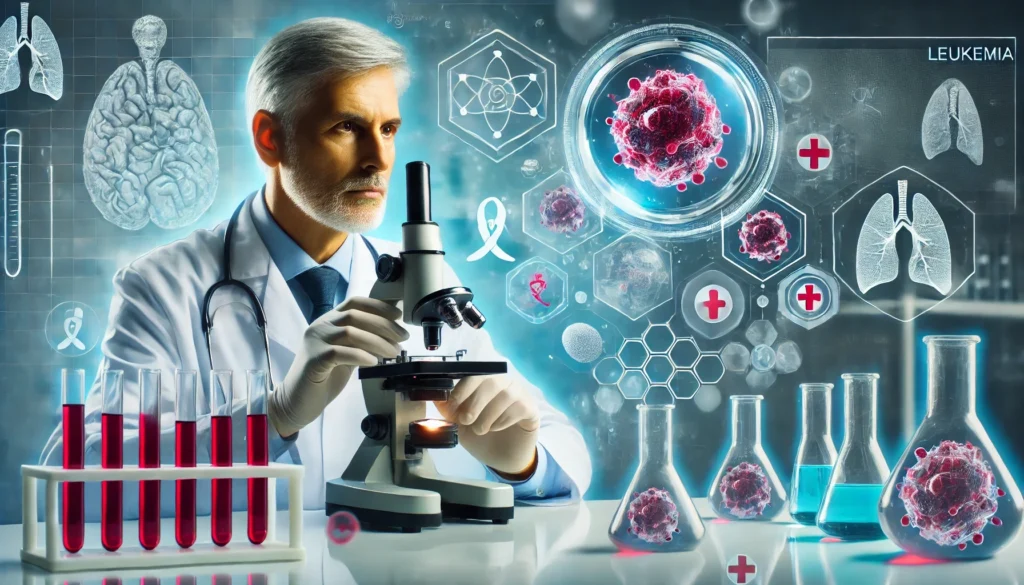Introduction
Leukemia is a complex and multifaceted malignancy that affects blood-forming tissues, primarily the bone marrow and lymphatic system. It encompasses a variety of subtypes, each with distinct pathological mechanisms and treatment approaches. Over the years, advancements in pharmacology have significantly improved survival rates and quality of life for leukemia patients. The development of targeted leukemia drugs and innovative treatment strategies has revolutionized the management of the disease. This article explores the best leukemia meds available today, analyzing their effectiveness, mechanisms of action, and potential side effects to provide a comprehensive resource for patients, caregivers, and healthcare professionals.
You May Also Like: List of New Medications: Breakthrough Treatments and Innovations in Modern Medicine
Understanding Leukemia and Its Classification
Leukemia is broadly categorized into four main types: acute lymphoblastic leukemia (ALL), acute myeloid leukemia (AML), chronic lymphocytic leukemia (CLL), and chronic myeloid leukemia (CML). Each type has distinct clinical presentations, progression patterns, and treatment approaches. Acute leukemias progress rapidly and require immediate intervention, whereas chronic leukemias tend to develop more slowly and may not necessitate immediate treatment.
Acute lymphoblastic leukemia (ALL) primarily affects children but can also occur in adults. It originates in immature lymphocytes and progresses rapidly. Standard treatment includes chemotherapy, targeted therapy, and, in some cases, stem cell transplantation. Medications such as asparaginase, corticosteroids, and tyrosine kinase inhibitors (TKIs) play a crucial role in its management.
Acute myeloid leukemia (AML) is more prevalent in adults and is characterized by the rapid proliferation of abnormal myeloid cells. Standard treatment includes intensive chemotherapy with drugs such as cytarabine and anthracyclines, as well as targeted therapies like FLT3 inhibitors for specific mutations.
Chronic lymphocytic leukemia (CLL) is a slow-growing leukemia that predominantly affects older adults. Treatment strategies often include monoclonal antibodies, Bruton’s tyrosine kinase (BTK) inhibitors, and chemotherapy.
Chronic myeloid leukemia (CML) is primarily driven by the BCR-ABL fusion gene, making it highly responsive to TKIs like imatinib. The advent of TKIs has transformed CML into a manageable chronic condition for many patients.

Pharmacological Treatments for Leukemia
The treatment of leukemia has evolved significantly with the introduction of novel pharmacological agents. Traditional chemotherapy remains a cornerstone of treatment, but targeted therapies and immunotherapies have gained prominence in recent years.
Chemotherapy has long been the backbone of leukemia treatment. It works by targeting rapidly dividing cells, a hallmark of cancer. However, its non-selective nature leads to significant side effects, including myelosuppression, gastrointestinal distress, and increased infection risk. Drugs such as cytarabine, a pyrimidine analog that inhibits DNA synthesis, are commonly used in AML treatment. Anthracyclines, including daunorubicin and doxorubicin, intercalate into DNA, disrupting replication and transcription. Methotrexate, a folate antagonist, is widely used in ALL treatment to inhibit dihydrofolate reductase, thereby preventing DNA synthesis.
Targeted therapy represents a significant advancement in leukemia treatment, focusing on specific molecular abnormalities that drive cancer progression. Tyrosine kinase inhibitors (TKIs) such as imatinib, dasatinib, and nilotinib have revolutionized CML management by inhibiting BCR-ABL activity. FLT3 inhibitors like midostaurin are used in FLT3-mutated AML to inhibit aberrant signaling pathways. Bruton’s tyrosine kinase (BTK) inhibitors, such as ibrutinib, block B-cell receptor signaling in CLL, reducing proliferation and survival of leukemia cells.
Immunotherapy leverages the body’s immune system to combat leukemia more effectively. Monoclonal antibodies, such as rituximab, target CD20 on B-cells and are commonly used in CLL treatment. Blinatumomab, a bispecific T-cell engager (BiTE), binds CD19 on leukemia cells and CD3 on T-cells, enhancing immune response. Chimeric antigen receptor T-cell therapy (CAR-T), including tisagenlecleucel, has shown remarkable success in treating relapsed or refractory ALL by reprogramming a patient’s own T cells to attack leukemia cells.
Stem cell transplantation is another treatment option for high-risk leukemia patients, offering a potential cure by replacing diseased marrow with healthy donor cells. This approach is often reserved for cases where standard therapies fail, particularly in aggressive subtypes of leukemia.
Evaluating Treatment Effectiveness
The effectiveness of leukemia drugs depends on several factors, including leukemia subtype, genetic mutations, patient age, and overall health. Clinical trials and real-world data provide valuable insights into treatment outcomes. Survival rates have significantly improved with TKIs, especially in CML, where patients often achieve near-normal life expectancy. Minimal residual disease (MRD) negativity, an indicator of successful leukemia eradication, is a key treatment goal. Side effect profiles also play a crucial role in determining treatment suitability, as newer targeted therapies generally have fewer adverse effects than traditional chemotherapy, improving patient quality of life.
Future Directions in Leukemia Treatment
Ongoing research continues to explore novel therapeutic approaches, including next-generation TKIs, bispecific antibodies, and epigenetic modulators. Personalized medicine, driven by genomic profiling, holds promise for optimizing leukemia treatment and minimizing toxicity. Researchers are investigating how combining multiple targeted therapies may enhance treatment efficacy while reducing the risk of resistance. Additionally, advances in immunotherapy, such as next-generation CAR-T cell therapies and immune checkpoint inhibitors, are expected to further refine leukemia management.

Frequently Asked Questions (FAQ) on Leukemia Medications
1. How do leukemia meds differ from traditional chemotherapy?
Leukemia meds include a broad spectrum of pharmacological treatments that range from traditional chemotherapy to targeted and immunotherapy drugs. Unlike conventional chemotherapy, which indiscriminately kills rapidly dividing cells, newer leukemia drugs focus on specific molecular pathways that contribute to leukemia growth. Targeted therapies, such as tyrosine kinase inhibitors, disrupt the signaling pathways essential for leukemia cell survival while sparing normal cells, reducing overall toxicity. Immunotherapy, such as CAR-T cell therapy, harnesses the body’s immune system to recognize and destroy leukemia cells more efficiently. The evolution of leukemia meds has significantly improved survival rates and minimized the severe side effects associated with traditional treatments.
2. What role do targeted therapies play in leukemia treatment?
Targeted therapies have revolutionized leukemia treatment by addressing the genetic mutations and abnormalities specific to different leukemia subtypes. These leukemia drugs inhibit key proteins, such as tyrosine kinases in chronic myeloid leukemia (CML) or FLT3 in acute myeloid leukemia (AML), which drive cancer progression. By selectively attacking cancer cells while sparing healthy ones, targeted therapies improve patient outcomes with fewer adverse effects. Moreover, these treatments are often used in combination with chemotherapy or immunotherapy to enhance effectiveness. Ongoing research continues to develop next-generation targeted leukemia meds with improved efficacy and resistance profiles.
3. Are leukemia drugs effective for all types of leukemia?
The effectiveness of leukemia drugs depends on the specific leukemia type, its genetic profile, and the patient’s overall health. While chronic myeloid leukemia (CML) responds exceptionally well to tyrosine kinase inhibitors, acute myeloid leukemia (AML) often requires a combination of chemotherapy, targeted therapy, and, in some cases, stem cell transplantation. Acute lymphoblastic leukemia (ALL) has seen significant improvements with immunotherapies such as CAR-T cell treatments and monoclonal antibodies. Chronic lymphocytic leukemia (CLL) patients may benefit from Bruton’s tyrosine kinase (BTK) inhibitors and BCL-2 inhibitors. Personalized medicine, which tailors leukemia meds based on genetic markers, is increasingly shaping treatment strategies for optimal outcomes.
4. What are the most common side effects of leukemia meds?
Leukemia meds vary in their side effect profiles, with traditional chemotherapy often causing nausea, fatigue, and myelosuppression due to its broad cytotoxic effects. Targeted therapies typically have fewer side effects but may cause cardiovascular issues, gastrointestinal discomfort, or skin reactions. Immunotherapies can lead to cytokine release syndrome (CRS), a severe immune reaction requiring immediate medical intervention. Long-term leukemia drug use may also increase the risk of secondary cancers or organ toxicity. Monitoring and supportive care strategies, including medication adjustments and symptom management, help mitigate these risks and improve patient comfort during treatment.
5. How do leukemia meds impact long-term survival rates?
Advances in leukemia drugs have dramatically improved long-term survival rates, particularly for chronic leukemia patients. Tyrosine kinase inhibitors have transformed CML into a manageable chronic condition, with many patients achieving near-normal life expectancy. Similarly, immunotherapies and targeted agents have increased remission rates for acute leukemia subtypes. Despite these advances, resistance to treatment remains a challenge, necessitating combination therapies and ongoing drug development. Clinical trials continue to explore novel leukemia meds that enhance long-term disease control while minimizing relapse risks.
6. Can leukemia drugs be combined with other treatments?
Yes, leukemia drugs are often used in combination with chemotherapy, radiation, or stem cell transplantation to maximize treatment effectiveness. For instance, FLT3 inhibitors in AML are frequently combined with standard chemotherapy to improve remission rates. In ALL, targeted therapies like blinatumomab can be used alongside chemotherapy to enhance treatment response. Immunotherapies, including CAR-T cell therapy, may be reserved for refractory cases or combined with other leukemia meds to improve durability of remission. The choice of combination therapy is guided by disease subtype, genetic markers, and patient-specific factors.
7. Are there any natural alternatives to leukemia medications?
While some patients explore complementary therapies such as dietary changes, herbal supplements, or acupuncture, no natural alternative has been scientifically proven to replace leukemia meds. Certain natural compounds, such as curcumin and resveratrol, have shown potential anti-cancer properties in laboratory studies, but their efficacy in leukemia treatment remains unconfirmed. Patients should consult with their oncologist before incorporating any alternative therapies, as some supplements may interfere with leukemia drugs. Integrative approaches that combine conventional treatment with supportive natural therapies may improve overall well-being without compromising the effectiveness of leukemia meds.
8. How are leukemia meds monitored for effectiveness?
Doctors monitor leukemia drug effectiveness using a combination of blood tests, bone marrow biopsies, and molecular testing. Minimal residual disease (MRD) assessment helps determine whether leukemia cells remain after treatment, guiding therapy adjustments if necessary. Imaging studies, such as PET or CT scans, may be used in cases where leukemia affects lymphatic tissues. For patients on tyrosine kinase inhibitors, periodic BCR-ABL testing ensures the drug continues to suppress the leukemia-driving mutation effectively. Regular follow-ups and personalized treatment modifications help optimize leukemia drug efficacy and prevent disease relapse.
9. What new leukemia drugs are currently in development?
The field of leukemia treatment is rapidly evolving, with numerous investigational leukemia meds in development. Next-generation tyrosine kinase inhibitors aim to overcome resistance seen with earlier drugs, offering more potent and selective inhibition of cancer-driving mutations. Novel monoclonal antibodies and bispecific T-cell engagers (BiTEs) are enhancing immunotherapy options for relapsed or refractory cases. Epigenetic therapies targeting DNA methylation and histone modifications are being explored to disrupt leukemia cell survival mechanisms. The future of leukemia drugs is focused on precision medicine, with therapies tailored to individual patient profiles for maximum effectiveness.
10. How can patients access new leukemia medications?
Patients can access new leukemia drugs through clinical trials, compassionate use programs, or off-label prescribing when standard treatments fail. Many cancer centers participate in clinical trials investigating novel leukemia meds, providing eligible patients with early access to groundbreaking treatments. Pharmaceutical companies and regulatory agencies also offer expanded access programs for promising investigational drugs. Discussing options with an oncologist is crucial for understanding eligibility and potential risks associated with experimental treatments. Staying informed about leukemia drug advancements ensures patients can explore the most effective treatment options available.

Conclusion
Leukemia treatment has witnessed remarkable advancements, with leukemia meds evolving from conventional chemotherapy to sophisticated targeted therapies and immunotherapies. While significant progress has been made, challenges remain, necessitating continued research and innovation. Understanding the available treatment options and their effectiveness empowers patients and healthcare providers to make informed decisions, ultimately improving patient outcomes and survival rates.
leukemia treatment options, blood cancer therapies, targeted cancer drugs, immunotherapy for leukemia, chemotherapy advancements, hematologic malignancies, chronic leukemia management, acute leukemia care, stem cell transplant for leukemia, monoclonal antibodies in cancer, precision medicine in oncology, emerging leukemia treatments, cancer drug resistance, personalized cancer therapy, hematopoietic stem cell therapy, novel cancer medications, breakthroughs in leukemia care, oncology drug development, leukemia survival rates, advanced blood cancer treatment
Further Reading:
Current status and research directions in acute myeloid leukemia
Management of Acute Myeloid Leukemia: Current Treatment Options and Future Perspectives


